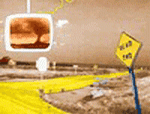

 |
|||||||||||||||||||||||||||||||
|
| |||||||||||||||||||||||||||||||
|
STATEMENT: "Home Like No Place is an online installation; it is a space of enchantment, a land of wonders somewhere between the Canadian Prairies (where I come from) and New York (where I live). Is is like an interactive gaming space, where the visitor can choose his own plot, as in an interactive roleplaying books. Colour symbolism from the Wizard of Oz saturates the nonlinear narration: hope (gold), freshness (green), poison and magic (red), and innocence (bleu) colour the postindustrial landscape. There's neither beginning and nor end, neither resolution nor moral. The visitor is also invited to write his own parts of the story - a process that leads the story to change and grow through time." (Jillian Mcdonald) "No place like home," goes the proverb. "Home like no Place" McDonald tells us instead. By inverting the terms, McDonald tells the visitor, in a sense, that this place (this non-place - "like no place," she warns) in which she invites him will doubtless lead to an experience much less of comfort and typical home familiarity than of considerably more obscure feelings, at once of enchantment and strangeness. A (non-)pace, where the natural world (too natural, hyper-natural), the urban world, and the world of fairy tales (The Wizard of Oz, of course, but also Rapunzel (cf. the "dungeon" scene) and Alice in Wonderland (with the appearance of a white rabbit)) meet and overlap to create a truly unparalleled space, colourful, playful, yet vaguely menacing and intriguing as well - and it's just this vagueness and menace that make it alluring. Thus, on entering, the visitor is greeted with a herd of bison - real, too real -, looking like stuffed animals, yet appearing to live and move nevertheless, in a landscape also more vibrant than life, under an overly blue sky, on grass (that one helps grow by clicking) too green, a veritable scene, combining National Geographic, acid-induced hyper-realism and a totally artificial cartoon aesthetic. But suddenly a branch falls, a bison watches its descent and lowers its head, a rainbow appears. A bird perches on a bison's back; it enlarges as the cursor hovers near it, diminishes as it moves away: then, on a click, it delivers a framed message that floats over the landscape: somewhere". Clicking on a word or a verse leads us to another tableau, depending on the choice we make. To describe all the possibilities would be tedious; besides, the pleasure we derive from this work resides in discovery, the unexpected, the charm of assemblages, and of watching the occurrence of such small events - the rainbow that appears, rain falling, grass and flowers growing, an insect climbing, lightning unleashed, a house that flies, a rabbit passing -, events that are sometimes triggered by a mouse-click, but sometimes independently of us, playing themselves out, as if by some inevitability, like a rite, a myth whose secret is lost, or not yet interpreted. In these varied little worlds, little scenes (in Freud's sense - the scene of dreams) - primed and artificial, yet more-than-real in that they may constitute revelations, not only for whomever can read them, but also because the dream, whether or not it remains enigmatic, always amounts to an outlet, or exit, in any case - we feel by turns and simultaneously like participants and strangers. Should we, after all, believe ourselves to be "at home" in this work? Does she speak to us, after all, does she speak of us, in spite of us? For from time to time, we "are told" of messages or questions addressed to us - the visitor. That is when we feel just a little afraid: in what world have we fallen? (We "are asked," also, to respond to various queries, by writing our answers in little boxes and clicking to send them: "Where do you find your poisonous substances?", "pregnant? not pregnant?", "i do | never" - the last two accompanied by the image of a pill - "have you had any luck at the 'end of the road'?".) Road signs appear ("arrêt," "no trespassing") and announce that more messages await us. The latter will sometimes consist of somewhat enigmatic verse, sometimes also of a montage of neon sign images, typically urban, too urban (bar, sex, seedy hotel). Never any people in these scenes: except for feet (shod in Dorothy's magic red shoes) and hands (those, we are told, of a magician). In the Wizard of Oz, having wished to be elsewhere, and having found herself, following that wish, in the magic world of Oz, Dorothy yearned with all her heart to get out and back home. Are we as weak-willed? Having gone from our everyday black and white world to the colour world of dream and fable, is our desire, like hers, not wholly to return home? Too much colour may be unbearable, and the possibility of parallel worlds will always both attract and repel. That is their purpose. N.B. Home Like No Place is a bilingual work (offered in French and in English).
Anne-Marie Boisvert
|
||||||||||||||||||||||||||||||

